Nursing Strikes and Starting Solid Foods with Erin Walsh, MA, CCC-SLP, IBCLC, BCS-S
- What a nursing strike is and what some of the causes might be to less breastfeeding
- How to re-establish a connection with your nursing baby if they’re getting distracted
- How to organize solid food feedings around continued breastfeeding for older babies
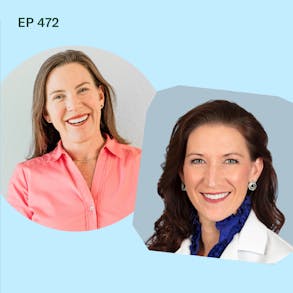
LISTEN TO THIS EPISODE
Episode Description
What if your baby suddenly stops breastfeeding around the time they also start solid foods. What is a nursing strike and how do you get your baby interested in breastmilk again? Erin Walsh is an SLP who also specializes in breastfeeding and she’s here to talk about nursing strikes and how breastfeeding changes when your baby starts solid foods.
About the Guest
- Erin Walsh is a speech language pathologist who specializes in infant feeding and breastfeeding.
- She is working on a Smart Pacifier that will help give clarity to potential oral problems in infancy.
Other Episodes Related to this Topic
- Episode 436 - How Long Can I Breastfeed? with Ronietra Stewart, RDN, IBCLC
- Episode 424 - Breastfeeding & Starting Solid Foods: When Will My Milk Supply Drop Off? with Jessica Smith, MSN, RN, IBCLC
- Episode 150 - Breastfeeding + BLW: How to Succeed at Both Simultaneously with Heather Dvorak, IBCLC
Links from Episode
- Learn more about Erin’s smart pacifier that she’s working on at https://latchability.com/
- Baby-Led Weaning with Katie Ferraro program with the 100 First Foods™ Daily Meal Plan, join here: https://babyledweaning.co/program
- Baby-Led Weaning for Beginners free online workshop with 100 First Foods™ list to all attendees, register here: https://babyledweaning.co/baby-led-weaning-for-beginners
Resources & Research
- Research articles on sucking by Erin and her colleagues:
- Truong, Phuong et al. “Non-Nutritive Suckling System for Real-Time Characterization of Intraoral Vacuum Profile in Full Term Neonates.” IEEE journal of translational engineering in health and medicine vol. 11 107-115. 23 Dec. 2022, doi:10.1109/JTEHM.2022.3231788
- Truong, Phuong et al. “Application of Statistical Analysis and Machine Learning to Identify Infants' Abnormal Suckling Behavior.” IEEE journal of translational engineering in health and medicine vol. 12 435-447. 17 Apr. 2024, doi:10.1109/JTEHM.2024.3390589
- Research articles on nursing strikes mentioned by Erin in the interview:
- Nayyeri, Fatemeh et al. “Frequency of "Nursing Strike" among 6-Month-Old Infants, at East Tehran Health Center and Contributing Factors.” Journal of family & reproductive health vol. 9,3 (2015): 137-40.
- Jalali, Fatemeh et al. “Nursing strikes among infants and its affecting factors in Rafsanjan city.” Journal of medicine and life vol. 14,1 (2021): 56-60. doi:10.25122/jml-2020-0118

Latest Episodes
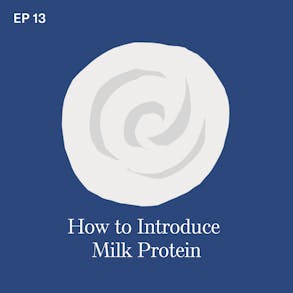
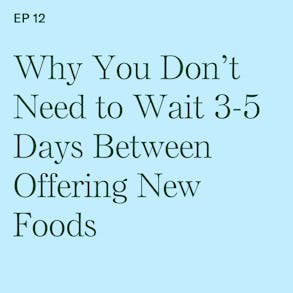

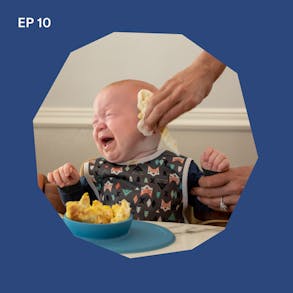

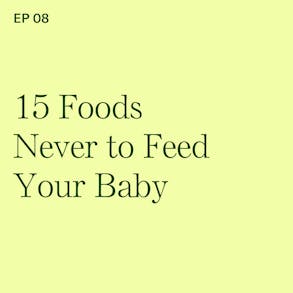
Katie Ferraro (0s):
How is the mental load of motherhood going for you? This baby stuff is a lot, right? Well my goal is to give you one less thing to worry about and that's Hmm. what am I gonna feed the baby If? you are looking for a one stop solution that literally teaches you exactly how to safely help your baby learn how to eat real food. I wanna invite you to join my signature online program called Baby-Led Weaning with Katie Ferraro. This is the most comprehensive baby-led weaning program out there. I give you 20 weeks of meal plans for baby-led weaning to help your baby safely eat five new foods a week, which means they're going to finish their 100 First Foods before turning one As one mom who recently joined the program said quote, our lifestyle does not give us any mental capacity to think more about what to do with this baby.
Katie Ferraro (45s):
This program caters to our needs inside of the program. I have my 100 FIRST FOODS content library to show you exactly how to safely prepare all of the 100 FIRST FOODS for your baby's current age and stage. My 100 First Foods, Daily Meal Plan is also included in there. It's all in one place. And a mom in our program, she said she joined because quote, I'm too tired of trying to figure out so many different things at once. I want someone to tell me what to do to catch up my nine month so we can stop using the same familiar foods we've been feeding her. If you are a type A organized per person or like let's say you wanna be that kind of person, you wanna be more organized in what you feed your baby, then I created the Baby-Led Weaning with Katie Ferraro Program for you.
Katie Ferraro (1m 28s):
You can sign up at babyledweaning.co/program. I have one program with all the stuff you need inside of it to get this thing done and get on with your life. Again, that's babyledweaning.co/program. Check it out and I hope to see you there.
To Kill A Mockingbird (Broadway Show) (1m 41s):
If you are in the market for a new highchair, I just got a Mockingbird highchair and I absolutely love it. Now you might know Mockingbird from their famous single to double stroller and usually when a stroller brand launches a highchair, not to be rude, but sometimes it is not that awesome. That is not the case with Mockingbird. They totally knocked it outta the park on this high chair. So in order to support a safe swallow, I only use highchair with adjustable footrests and the Mockingbird High Chair. Their footrest has four heights to choose from and that's better than a lot of brands that say they have an adjustable foot rest. And it only goes to two like very random heights if you use a tray. The Mockingbird High chair also comes standard with the tray so you don't have to buy it separately like you do with a lot of other brands. And the tray has three depth positions to grow with your baby too. The tray liner pops off and you can throw it in the top rack of your dishwasher for easy cleaning. Now because of the Mockingbird Highchairs unique design, you can also use it safely without the tray and I love that you can just pull your baby right up to the table to participate in mealtimes and baby-led weaning. Probably my favorite feature though are these beautiful soft silicone straps that are so easy to clean and then they have this genius like low profile hook system behind the chair to hold the straps back when you're also cleaning. Basically, this high chair has it all and it's really reasonably priced for a very beautiful and safe modern high chair. Mockingbird is offering a very nice deal for our listeners right now. When you purchase the Mockingbird Highchair, you will get their early eaters dishware set, which also includes a cup spoons, it has a suction bowl and a lid and a silicone bib. That whole set is free. That's a $45 value when you buy the highchair. And use the code BABYLED at checkout. So just head to hello mockingbird.com, put the Mockingbird Highchair and their Early Eaters dishware set into your cart. Enter the code, baby lead and the dishware will be free. Again, that code is BABYLED, LED at hellomockingbird.com and definitely check out the Mockingbird highchair.
Erin Walsh (3m 42s):
I think it is really, really critical to not force the baby. I've heard some scary stories that if your baby gets hungry enough they'll nurse, but you know that approach doesn't really establish trust.
Katie Ferraro (3m 57s):
Hey there, I'm Katie Ferraro, registered dietitian, college nutrition professor and mom of seven specializing in baby-led weaning here on the Baby-Led Weaning with Katie Ferraro Podcast. I help you strip out all of the noise and nonsense about feeding, giving you the confidence and knowledge you need to give your baby a safe start to solid foods using baby-led weaning. What is a nursing strike? A nursing strike is a temporary period when your baby who's been breastfeeding well, they suddenly will start to refuse to nurse. And that change in behavior can be so confusing. It can be so stressful for both the baby and the mom, but it usually happens for a couple of different reasons and it's not a signal that your baby is ready to wean.
Katie Ferraro (4m 45s):
So what are some reasons why a baby might quote unquote strike? Okay, it might be teething or illness. They've got pain in their gums or their ears and that sucking experience can be uncomfortable, might be changes in the routine or the environment like if you're traveling or there's a new caregiver or distraction. Some moms experience reduced supply or flow and we're gonna talk about that today. Also, sometimes a mom's reaction if the mom is reacting strongly doing the biting or other behavior during nursing, that baby might become hesitant to nurse and a nursing strike can last for a few days to over a week. But with a lot of patients, most babies are going to return to breastfeeding. But I know that interim period as a mom feels so scary. And my guest today is here to talk about nursing strikes and changes in breastfeeding when your baby starts.
Katie Ferraro (5m 32s):
Solid foods, her name is Erin Walsh. She's a speech language pathologist and she's an IBCLC, so that means she's internationally board certified lactation consultant. But as a speech and language pathologist, she has a really interesting job. So she works at UC, San Diego, which is an academic medical center here in San Diego where I live and I know her through other colleagues. Her expertise is that she works in an ENT clinic. So she works with three surgeons, six speech pathologists, and she has a very, very interesting background. She'd always worked with professional singers and people who had voice problems. She actually has a piano in her room. She said that voice problems in musicians, singers are almost always paired with an airway or a swallowing disorder.
Katie Ferraro (6m 13s):
So she actually didn't intend to become an SLP. She said she went to college for singing and kind of fell into this area. Now she's been an SLP for over 20 years. She's been an IBCLC, so specializing in breastfeeding for over 15 years. Her expertise is in helping families establish breastfeeding just after birth. And then if things start to go awry and they need help with continued breastfeeding, that's where Erin comes in. So she does a lot of work on oral motor function. She does research in this area. She's working on a smart pacifier with some engineers, which I think is a very exciting business opportunity that she's exploring.
Katie Ferraro (6m 53s):
And Erin did a deep dive on the research about nursing strikes and it was pretty interesting that really there's only two published studies about nursing strikes out of Iran and there's just not a lot of data about this. So what Erin's bringing to this interview is her expertise from an anecdotal standpoint, what do parents tell her about when they're starting solid foods about the changes that they're experiencing in breastfeeding and then how can she uses the word organize, which I love when therapists use that word a lot. How do you organize the solid food feeds with the continued breastfeeding? And of course as an IBCLC breastfeeding expert, she's really, really gonna help her clients try to stay committed to breastfeeding for beyond the one year mark.
Katie Ferraro (7m 33s):
And she'll talk a little bit about that as well. So with no further ado, I wanna introduce you to Erin Walsh. She's talking about nursing strikes and changes in breastfeeding when starting solid foods.
Erin Walsh (7m 49s):
More often than not what constitutes true nursing strike. I've seen more commonly in in babies before they're even eating solids. But many families come in with questions about how do you organize taking solids with breastfeeding.
Katie Ferraro (8m 3s):
Erin, can you tell us a little bit about the research around nursing strikes? 'cause as I understand it, there's not a whole lot that has been published about this idea of a nursing strike.
Erin Walsh (8m 14s):
I found two studies on PubMed in the last 10 years about nursing strikes and they were both out of Iran. The first was published in 2015 and it looked at infants that were attending their routine six month well child check. They had 175 infants that were enrolled in the study. And they found that 24% of babies at some point exhibited behavior that was consistent with a nursing strike and realized this is before solids are introduced. So I think that's important to note. I see many of them that's before solids are introduced and it was most commonly associated with maternal education and working status, which of course smarted a bit 'cause that's me or was me.
Erin Walsh (9m 5s):
And other factors that they discovered included age appropriate playfulness. So it was really normal for a baby around three or four months to have lots of squirrel moments. And every personality's different, but sometimes you gotta be in a really dark room to get 'em to eat. And then they also talked about nasal obstruction being a cause of a nursing strike. The other study was published in 2021 and they found 70 infants who came to the doctor because of a nursing strike that. And they took demographics on the mom and on the baby and they found the following factors associated with breast refusal. 50% was just these squirrel moments.
Erin Walsh (9m 46s):
They were just distractible and interested in the world. 48% have vaccinations in the preceding 12 days. So they just didn't feel well. And then the maternal factors, they came back to the higher levels of education. So since 67% involved parents who had presumably gone back to work, 41% related to acute stress. And then I was really surprised that only 35% was a drop in milk supply because that's anecdotally what I've seen a lot of. But you know, don't quote me on this, but I, I'd make the case that maybe someone went back to work, it was really stressful and then their supply went down.
Katie Ferraro (10m 28s):
So, Erin, when you were looking in the literature at a nursing strike, like I know it's a term that gets thrown around probably very loosely, like many things in the infant feeding world in social media or in moms groups. What especially do the researchers look at to constitute a quote unquote nursing strike? Like what is that consistent behavior that they're gonna say, okay, yes, this is a nursing strike.
Erin Walsh (10m 50s):
Weaning is gradual and not abrupt. I think that's important to note. So a nursing strike is a sudden refusal to latched and drink from the parent.
Katie Ferraro (11m 3s):
And does it mean that like the baby totally goes down to nothing? I mean you were mentioning that there's, you know, squirrely babies that are, you know, kind of shiny object syndrome looking around at everything and maybe not paying attention. Or is it like a nursing strike is like, oh my gosh, my baby had zero intake for three days. Or is it just kind of anecdotal
Erin Walsh (11m 22s):
That there's sort of variations of that? The squirrel moments I think maybe aren't, I think that's a distracted baby and not really a baby that's on a nursing strike. And then there are other babies and I would say it's, it's very personality dependent. I mean the, the personalities of my two children now age eight and 13, totally played out from when there were babies. You know, they, one of them wanted everything to be just so when it was time to eat. And they're still like that. You know, there are some kids when they go to, maybe they have a caregiver and they start having bottles in a, in a ritual that happens when they're not with their mom in nursing.
Erin Walsh (12m 5s):
And it can really throw things topsy-turvy and it can be hard to get that baby to latch again and others just don't care. They'll eat whatever you give them and they're real easygoing. So it's very personality dependent.
Katie Ferraro (12m 17s):
Hey, we're gonna take a quick break, but I'll be right back And you mentioned that sometimes with clients if a baby's getting distracted or there's a dip in maybe their intake, you know, anytime there's a change in the schedule it kind of throws everybody for a loop and you sometimes have to pivot and figure out what works this week, what worked last week doesn't work.
Katie Ferraro (13m 42s):
You mentioned like for example, certain babies need to eat in a dark room. What are some other tips that you have for parents if they have noticed, you know, a change in their baby's interest level of breastfeeding without forcing the baby to drink what they're not inclined to? What can parents do to kind of redirect that baby's attention?
Erin Walsh (13m 60s):
I think it is really, really critical to not force the baby. I've heard some scary stories that if your baby gets hungry enough they'll nurse. But you know, that approach doesn't really establish trust. And so I would say that persistence and patience and we all lead really busy lives and it would be great if they're on our schedule, but they're just not. Sometimes I've had some families just try to cancel plans and just the, the parent and the baby spend time together where it can really be a, an on demand situation and not wedged in between a soccer game and you know, church camp and all these other things that happen in life that it's hard for some kids to do that Everyone has a different dynamic and I think that's what I like the most about my job is I get to be really creative and find out who lives at home, what's your schedule like, how can we do this?
Erin Walsh (14m 60s):
And for some kids that are really rigidly objecting to latching, what one of the options will be is, you know, babies have many moments of just discontent 'cause that's normal baby behavior. And so to latch without when they're not hungry without the demand of feeding can be helpful and in a back door. So maybe they had a bottle or they drink from a cup or not an artificial nipple, that might even be more helpful. And then as their ritual when they're fussy or as they're drowsy and about to take a nap or right when they wake up from a nap, just to hold them really close and allow them to latch but they're not hungry so they don't get frustrated.
Katie Ferraro (15m 44s):
And I know we were talking earlier about just the anxiety level of parents and your job is so interesting, but also I would say, I bet sometimes it's kind of overwhelming for you too because people don't come to you when everything's going hunky dory. Like they're coming and seeking help because they're struggling with feeding and feeding challenges and when you know, some parents, they're really, really attached to their schedule. I know I have, I'm a mom of seven, I have a set of quadruplets and a set of twins and the schedule was everything for us. And I, I never breastfed them. I always pumped and then had to have help with bottles and stuff, but I kind of liked it because I'm so type A and then I could have this schedule, but now I'm working towards my IBCLC as well and just studying about how important it is to not be on a schedule.
Katie Ferraro (16m 30s):
Like how do you tell moms that who are like so live or die by the schedule, but like your baby's not and you can't, you have, do I have other stuff? You do have soccer camp and church camp or whatever. If you have other kids going or work, how do you navigate that? 'cause I can imagine that's challenging.
Erin Walsh (16m 45s):
I try to meet everyone where they're at. And so if there is someone who is inherently preferring a schedule, I work with it. If they want to pump, I'll show 'em how to pump because ultimately the lifelong benefits of the baby getting human milk and the mother breastfeeding are enormous. And if creating a loosey goosey schedule will ultimately stop them from breastfeeding, I think it's in everybody's best interest to, if you, if you wanna pump then we pump, but maybe do some direct latching. So the microbiome is good and so I try to work with everybody where they're at. It's not only you, the daunting thought of providing milk for seven children or or four at a time in your case or quadrant, how many do you have?
Katie Ferraro (17m 33s):
Well I have seven total, but I had quads and then I had twins. And you know what, when I had the quads, I only ever made enough for half of them. I was always 50 50, like 50% breast milk and I had to supplement 50% formula. And I thought, well if I ever have twins, at least I know I make enough. And then of course when I had twins I didn't make enough for the twins and I, I was like, this is so frustrating and I know how it all works. It's just when you're in the thick of it, you're like, I can't believe this is happening to me. Like how can I not provide for my baby? And then like you said, that stress sometimes causes you to spiral, which in turn negatively impacts your milk supply. So I can imagine a lot of your job is like helping to talk parents down and explaining what is typical behavior. 'cause if you've never done this before as a mom and you as a breastfeeding expert and an SLP, you've seen pretty much everything.
Katie Ferraro (18m 17s):
So you know, hey this is cause for concern and this is not like it's important to have this individual one-on-one care that I think not every mom has access to.
Erin Walsh (18m 27s):
Yeah, I always try to offer options and so it, it's not always that someone has a really intense schedule where they have other children or they say, I really prefer breastfeeding, it's just better for my mental health. But there are certain person, yeah, I talked about baby personalities, but we have personalities too and you know, there are some personalities that like things to the baby is fed every three hours and it's each breast for 15 minutes and you know, so I, I try to offer options and freedom within that and not tracking all the feeding on all the diapers on the app. And so it, it really works. It, it's personalized for each person that walks in the door and then I give them a plan for about seven days and then we talk about it in the next week.
Erin Walsh (19m 14s):
Like how did that work? Was that scary not having a schedule? Did you feel good about it? How can I help you? Because really the ultimate goal is to promote breastfeeding as long as possible. And even I think it's amazing that you provided as much milk as you did for your children. It doesn't matter that it wasn't everything that they drank, every little bit they got was enormously helpful. And so I just try to encourage families when they come in that it's not black and white at all. You can do many, many variations. There are also some situations where a parent can't produce the milk and so it doesn't mean that that person has to pump eight times a day with their only three ounce yield.
Erin Walsh (19m 59s):
It means that okay so your baby primarily bottle feeds and then you latch before and after and then they see you as a source of comfort and then you latch throughout the day. And all of that is a health gift for both. So I just try to meet everybody where they're at and come up with a plan that's sustainable.
Katie Ferraro (20m 19s):
So let's talk about when the baby goes to start solid foods, they're showing all the reliable signs of readiness to eat and they're past that six month mark. Yeah. The question that I heard you say before, mom say well how do I organize that? Like what tips do you have for parents who want to continue breastfeeding who know the importance of breast milk and human milk even after starting solid foods? What tips do you have for them and what problems do they typically encounter that you would see in your setting?
Erin Walsh (20m 44s):
The primary source of nutrition still is human milk. And when they start around six months playing with solid foods, it really takes as you know, a while to get the hang of it. And so it's not for nutrition, it's just to get the mechanics down and the amount, this is interesting, the amount of milk that they take is pretty steady. So after a baby is born close to a month, after about a month of breastfeeding, they settle in on 25 to 30 ounces and 24 hours. And that doesn't change for the first year of life and for their first six months when they're not having solids, they will stay on their growth curve.
Erin Walsh (21m 27s):
If they have 25 to 30 ounces in 24 hours now it'll be organized differently. So a baby right when they're born will need to nurse pretty often 'cause their tummies are small and they need to keep their blood sugar up and they don't sleep a lot at once but it changes as they get older. They might sleep longer at night, they might prefer to cluster feed at certain times of the day, but really the amount stays the same. And once they get the hang of solid foods around 6, 7, 8 months, then they do take that nutrition into account for their growth while they continue to drink 25 to 30 ounces a day of breast milk.
Erin Walsh (22m 8s):
And so I always like to assure that the baby is still getting enough breast milk. I like to say maybe you start the meal at breast and then the baby is in the chair and offered food and then maybe they have some playtime and then as they're about to go down for a nap, maybe you'd latch them again. But just to, if possible with a family schedule to have ad-lib times whenever the baby is frustrated or needs comfort, that lashing is very routinely part of that because the volume of milk can add up tremendously over the course of 24 hours and really meet that goal of 25 to 30 ounces and it stays that until they're about one.
Erin Walsh (22m 53s):
And then between one and two it, it goes down to maybe 20 ounces or so. But it's still a very significant part of their nutrition and and immunity and all the other things that I'm sure you're learning in your IBCLC program.
Katie Ferraro (23m 7s):
Hey, we're gonna take a quick break but I'll be right back.
Katie Ferraro (23m 50s):
My question for the moms that are exclusively breastfeeding up until the point when they're starting solid foods is I know that they don't trust their bodies. Like they can't see that 25 to 30 ounces. So they wonder, oh my gosh, well I noticed my baby is eating less. Especially around the eight month mark when babies really get the hang of picking that food up and bringing it to their mouth and the the moms will freak out, oh my gosh, they're nursing less frequently. You know, the sessions aren't, are shorter, you know, that's weaning in action, that's your baby. Gradually learning how to get more nutrition from food and gradually getting a little bit less from milk. And so if moms hear that 25 to 30 ounce message, if they're breastfeeding, do they sometimes stress out like, well I can't see it and I don't know if it's there.
Katie Ferraro (24m 31s):
How do you tell them like, yes, your baby's doing okay and your body's doing okay?
Erin Walsh (24m 36s):
I think I would hesitate to use the word weaning then because they're, you know, they're not mutually exclusive. So the supplement of adding solids is maybe the way that I would view that. And if a, unless your pediatrician says there is a problem with the growth tracking, then they're getting plenty. And if, if it's reassuring, families can go and weigh their babies and just make sure they're kind of plotting along the lines. But getting in the weeds of how much they take every feeding or every day can be stressful. If, if you are working and you have to pump and you put it in a bottle, then you can see how much it is.
Erin Walsh (25m 19s):
And if that helps your mental health to know how much you're giving, then you could pump and you could see it. Or you could have a scale and do 24 hours of weighted feeds and know. But I, I would say it's much more useful in your long-term relationship with your baby to like go to the beach and play than worry about how much milk there. You'll know if they're not gaining and your doctor sees you at certain intervals and they'll start to alert you to, oh is there an opportunity to give the baby more milk? And, and what I usually do with families that come in as I say, I want you to walk me through 24 hours, how do you feed your baby?
Erin Walsh (25m 59s):
Well you know, what's at breast, what solids do they take? And we just negotiate 'cause I want them to look back on this time with joy and not stress. And so if they're comfortable with it, the less you measure and the more it is just sort of a natural interaction between the two, the better.
Katie Ferraro (26m 18s):
You mentioned all the apps with the diapers and do you think all the apps are making parents more stressed out or are they helping or is it a matter of both?
Erin Walsh (26m 29s):
I love technology. I mentioned the smart pacifier. I mean that's the direction I like going in healthcare. 'cause I've been in healthcare for over 20 years and I love technology, but I think a lot is lost when a family goes home and everything is measured. And so I try to free them and liberalize the scenario a little bit 'cause your baby talks to you even though they don't talk to you, you know, they communicate and I, I love to help families learn what the baby is communicating, what's hunger, what's just a little bit of distress where they might need to be held and try to pick up on their cues because that will be invaluable.
Erin Walsh (27m 13s):
Not just from a nutrition standpoint, but just your relationship with your kids to sort of understand what they're wanting. Because your pediatrician will see you at many intervals and give you a heads up if things aren't tracking adequately. And, and they'll, they'll send you to someone who like me and I'll help you analyze it. And we can almost always find little ways of getting meals in, whether it's latching or more solids that will get them on track. You know, they're, it's a very commonly the third or fourth child and they need to be fed during pickups. And so when I have the parent write out exactly what they do in 24 hours, they say, oh yeah, I guess I'm not feeding them when I'm doing drop offs.
Erin Walsh (27m 58s):
You know, there's like simple things like that. And so I, I prefer to go through it that way than giving them something else to do where they have to enter it into an app.
Katie Ferraro (28m 7s):
What are some signs that parents should look for the cues, the little indicators that their baby is ready to start reducing either the breastfeeding frequency or the durations of the feeds as they get more proficient in eating food? How will you know that it's time to breastfeed less?
Erin Walsh (28m 25s):
What I will say is just to visualize all of this as complimentary feedings because the American Academy of Pediatrics shifted the advisable durability of breastfeeding from one year to two years and thereafter as desired by mother and child. And so I, I would always have it in the mix if you feed your baby a meal that the typical amounts you've been giving them, you know, 3, 4, 3 meals a day plus a lot of snacks and they still seem hungry, that's an opportunity to latch them. And if you are working and then that is pumped milk that you have in a cup for them.
Erin Walsh (29m 9s):
But I would make sure that they still have quite a bit of milk once they start solace 'cause they get so much nutrition from that, so much immunity. But it really is a pretty gradual process where as long as it's part of the routine, maybe before you leave for work or before you drop the other kids off in the morning that you have a devoted time where you're just with the baby and you allow them to nurse and the same team, the same thing for the evening routine. They, some kids take a lot right when they wake up and then have mostly solids during the day and maybe you pump some milk and they have that, that they're alternating with their solids.
Erin Walsh (29m 50s):
But I think as long as there is an opportunity right when they wake up before you feed them, that tends to be when babies will get a lot of volume and then maybe right when they're falling asleep.
Katie Ferraro (30m 2s):
So the schedule looks differently than it did in the first half of infancy the, they might still be taking the same volume but it might be spread over a different period of time or different number of nursing sessions. Is that safe to say?
Erin Walsh (30m 13s):
Yeah, and it depends on what the family does during the day. If both parents work and they go to daycare, then what makes sense is to nurse the baby in the morning and then send the baby with their solids and then pumped milk for the maybe three meals that they'll have and some snacks during the day. And then as part of their ritual when they're falling asleep they may nurse again. So it, it just looks a little bit differently, but certainly it's negotiable in whatever situation a family finds themselves in with a schedule.
Katie Ferraro (30m 46s):
Do you have tips for moms just kind of across the board to on maintaining their milk supply as the baby is starting to eat more solids and get more nutrition from food,
Erin Walsh (30m 60s):
As long as they're latching frequently the supply will be maintained and this is, you know, dangerous territory for people that like numbers. Yeah,
Katie Ferraro (31m 7s):
You're right. No, 'cause they'll say, well what do you mean how many times, just tell me, make me a schedule so I can follow it
Erin Walsh (31m 12s):
And if, if someone wants a schedule, I'll make them a schedule. But if possible, just making sure that you have that the morning routine, for example, in some situations babies will sleep a long time at night and if yours doesn't that's still normal. But some babies will sleep quite a while at night and then the breast will be very full in the morning and they get a lot of breast milk right when they wake up. And then, you know, they'd have breakfast an hour later and so that's very well organized. And then you might have something similar to the evening, maybe if the parent was working and their breasts are pretty full that you've done the evening routine and then it's time for the baby to fall asleep.
Erin Walsh (31m 55s):
They could also get quite a bit, some babies will get the vast majority of what they need just from those bookend nursing sessions. But I would say throughout the day, whenever, if you're with your baby during the day and they're putting their hand but their mouth or seeming a little bit fussy, always latch them. If they don't want it, they'll let you know, but always offer it.
Katie Ferraro (32m 18s):
Let's talk about the, if they don't want it, they'll let you know. 'cause I think again, this term nursing strike gets thrown around rather loosey goosey. If a mom is, oh my gosh, my baby is not latching as frequently or wanting to breastfeed as much at eight months as they were at five months and they come in and they're stressing out about that, what do you tell them as an SLP who's also specializing in breastfeeding?
Erin Walsh (32m 41s):
If the growth pattern looks good, I would offer reassurance. That's really typical. The baby is getting a lot of the nutrition from solids and to, if they're concerned that not enough breast milk is, is taken in within the 24 hours, you can put your express breast milk in their solids and your, that's your expertise. I'm sure you have many, many recipes in that realm, but there are ways that they can get the food if they're too, some babies are too distractible during the day to sit and cuddle their mom and nurse. And so that's why I mentioned the morning and evening sometimes that just, that dynamic works better and it's very focused and then they still get the milk during the day, but in, in a different way, in a different setting.
Erin Walsh (33m 28s):
So they can be real social and sit with their buddies at the table and eat and interact.
Katie Ferraro (33m 33s):
Hey, we're gonna take a quick break, but I'll be right back. Aaron, I wanna hear more about the smart pacifier. You mentioned it a little bit. I know you're interested in technology. Are the other pacifiers stupid? What makes a smart pacifier tell us all the things?
Erin Walsh (33m 54s):
So for all my other patients that come through, I have fancy tools to figure out what's going on. So if they're not swallowing well, I'll put a scope in their nose and I'll look at their throat while they're swallowing or I'll take an X-ray and figure out why, why aren't they swallowing the mouth is an enigma with the baby. And so many people will see lots of different breastfeeding medicine specialists and they get lots of different answers and it's really frustrating for them. And I think it is long overdue that that is not standardized. And so we, we do have pacifier that we're working on, we've studied that of course the hottest topic is tongue tie.
Erin Walsh (34m 37s):
We're not very good at using our finger, which is not surprising to figure out if a baby is sucking well or not. And so there's machine learning in this pacifier, there's, there is a vacuum in, it takes all of these different parameters and it puts them together. The first step in this is we'd like for pediatricians to have this. So it's like a pass fail. Like watch this baby. They might have trouble. But then for a more nuanced clinician who just does feeding disorders, we can turn all of the features on and say, well it was the, the second frequency was too high, the vacuum was too high, this was low.
Erin Walsh (35m 18s):
It's still far too subjective to use our finger and say, this baby can suck or they can't suck. Or just look in the mouth and say there's something under the tongue that's a problem. We should do something about it. When in many cases it's not intrusive or obstructive to a very healthy breastfeeding relationship. So we started this research out of UCSD that, that my very smart engineering colleagues, wonderful pediatricians that I get to work with at UCSD as well. But we've studied this and we actually created a business latch ability, but we'd really like this to be a product that is used in clinics by primary care providers.
Erin Walsh (36m 0s):
So they say, aha, this baby should be watched. They're at risk of having breastfeeding problems and then they get sent to a feeding specialist that can really dissect what's going on. Erin,
Katie Ferraro (36m 12s):
In closing, what do you recommend to parents who are at peak stress level and they're worried, my baby stopped breastfeeding after we started solid foods and the schedule's all messed up and I'm struggling here to get my baby to eat anything. How do they know when it's time to see a lactation expert? How do you find somebody with your background to work with? Where should they go if they feel like they can't do this on their own?
Erin Walsh (36m 38s):
There are a lot of clinicians and we all have slightly different backgrounds, so you might wanna see where someone's expertise lies. I don't know that you'll have to see a, a hybrid like me to do this. I think a lactation consultant, even with a different background, this would be very well suited and I would say go sooner than later. Also, there are many breastfeeding support groups around town online, CHE league, your friends who have had a baby. That's invaluable too. I think that's much more personalized than going in and Instagram wormhole in the middle of the night. Because as I mentioned before, and what I love about my job is everybody's situation is really different.
Erin Walsh (37m 22s):
And so to cut and paste to your circumstance is not helpful and more stressful. So go to someone early and let them map out, you know, show me 24 hours, what are we doing here? How's the weight tracking? And then let someone give you options about how it could better suit your family dynamic.
Katie Ferraro (37m 41s):
Well, thank you so much for sharing your time and all of this expertise with our audience. I really appreciate it.
Erin Walsh (37m 47s):
My pleasure. Thanks for having me.
Katie Ferraro (37m 49s):
Well, I hope you enjoyed that interview with Erin Walsh. She's from UC, San Diego, talking to us about some changes in breastfeeding, patterns in and around the time when your baby starts solid foods. I will put all of the references and resources that she talked about on the show notes page for this episode, which you can find at blwpodcast.com/472. A special thank you to our partners at AirWave Media. If you like podcasts that feature food and science and using your brain, check out some of the podcasts from AirWave. We're online at BLWpodcast.com. Thanks so much for listening, and I'll see you next time.
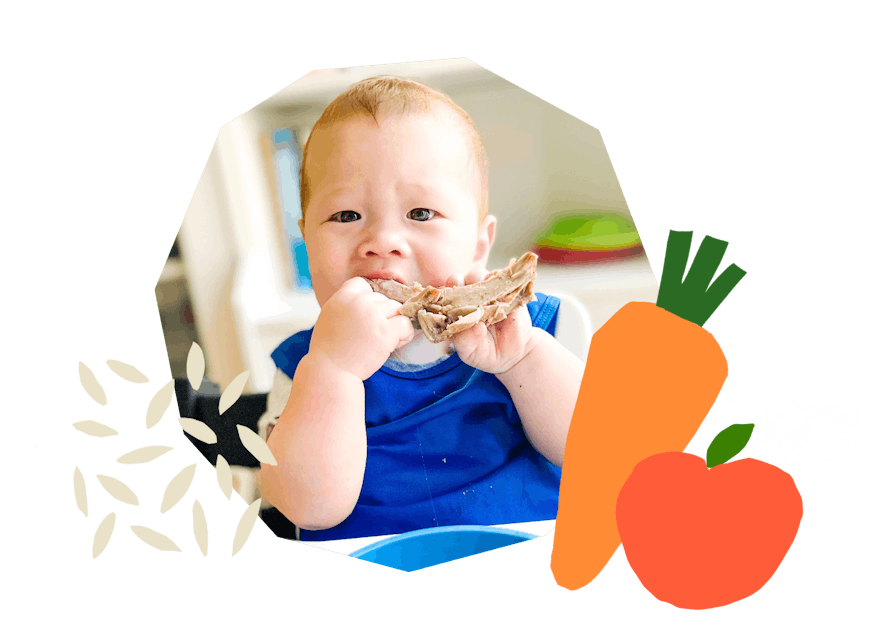
The Program Baby-Led Weaning with Katie Ferraro
A step-by-step digital program for starting solid foods safely and navigating the original 100 FIRST FOODS™ meal plan with baby-led weaning.
 EXPERT-LED, PROVEN APPROACH TO EATING REAL FOOD
EXPERT-LED, PROVEN APPROACH TO EATING REAL FOOD CONCISE VIDEO TRAININGS TO MASTER BABY-LED WEANING
CONCISE VIDEO TRAININGS TO MASTER BABY-LED WEANING 100 FIRST FOODS DAILY MEAL PLAN WITH FOOD PREP VIDEOS
100 FIRST FOODS DAILY MEAL PLAN WITH FOOD PREP VIDEOS
Baby-Led Weaning for Beginners Free Workshop
Is your baby ready to start solid foods, but you’re not sure what to do? Register for this free online video workshop and learn how to give your baby a safe start to solid foods using baby-led weaning. Everyone on this free training receives a copy of Katie’s original 100 FIRST FOODS™ list. You can take this workshop right now, later today when your baby naps, or tomorrow…whatever works for you!
Get baby-led weaning recipes and tips delivered to your email inbox.